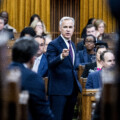I wish Parliament would occasionally meet on the “commons” (the common grazing lands) to make decisions as farmers and villagers did a thousand years ago, debating while listening to the birds and as shepherds gathered the flock. The outdoors could only make MPs more agreeable. They’d more readily appreciate that their food, water, clothing, housing, energy, and the air we breathe originates in nature and the land, not Walmart or the local gas station. Conservatives might recall their ancient connection to the land and transcendent responsibility to be “stewards” of a rich inheritance.
The name “conservative” should make it clear. Russell Kirk, author of, The Conservative Mind, Burke to Eliot, wrote in 1971 that “nothing is more conservative than conservation.” But, if the connection between conservation and conservatism still isn’t obvious, I’ll make my case.
First, a political argument. Valuing nature finds its greatest expression in rural areas, the conservative heartland. Conservative farmers and ranchers have long worked with conservation organizations, made up largely of conservative-leaning anglers and hunters, to preserve ecologically valuable lands. Conservation tax breaks and, more recently, direct payments have made it possible for landowners to continue farming and ranching while also conserving on what have become known as “working landscapes.” This decades-long relationship has succeeded in conserving millions of hectares of the best habitat in Canada.
Prime Minister Harper, who was no spendthrift, paid conservation organizations a high compliment in 2014 by entrusting them to drive a $252 million government of Canada commitment to preserving ecologically sensitive lands. He said that to achieve that “Canadians should become willingly and eagerly a community of stewards.” Conservative legislators today should build on this rich legacy. President Reagan said in his 1984 State of the Union address that “Preservation of the environment is not a liberal or conservative challenge. It is common sense.” It is also a powerful animating force in society.
Even before Sir John. A. Macdonald established Banff as our first national park in 1885, Canadians revered our natural inheritance. It is a dominant theme in our history, literature, and art, central in our national symbols, and core to our national identity. But we don’t just admire nature, we need it. It is the mind-altering drug that pulls us out of our smartphones and out of our own heads to look on in wonder at towering trees, an endless prairie sky, the crashing ocean, or our majestic mountains.
We need the solitude of nature so much that we spend thousands of dollars to go in large crowds to see it. Banff alone attracts as many as five million people a year. Nature tourism is a multi-billion-dollar business. There are votes in catering to anyone whose heart quickens when a moose enters the yard, or a fox runs across the campground. Conservation is the everyman approach to environmentalism. Conservatives should accept Harper’s challenge and encourage Canadians to become a “community of stewards.”

Carol Nichol, 74, runs her dog sledding team in early morning over frozen wetlands near Bobcaygeon, Ont., on February 11, 2021. Fred Thornhill/The Canadian Press.
Then there is that bracing “c” word, climate. Natural gas exports to replace coal, carbon capture, utilization, and storage, harnessing technology, and rolling out more nuclear energy are all needed to mitigate climate change, but they are long-term, and they aren’t enough. A vigorous approach to conservation would be an immediate and significant help.
There is a lot of carbon in a tree. A significant portion—11 percent, according to the UN Environment Programme—of the world’s annual GHG emissions come from deforestation and degradation. Canada’s forest lands footprint has been stable for the last 30-plus years, but before that we were anything but good stewards. On the Prairies we pulled down vast stands of aspen and poplar trees while draining 70 percent of our wetlands and ploughing up 80 percent of our native grasslands, all massive stores of carbon. Urban centres across southern Canada have cut down millions of hectares of trees and drained wetlands to make way for office towers, parking lots, and suburbs. We need places to live and work but we were often reckless in how and where we built.
Protecting what is left and restoring at least some of what we lost will cut GHGs while avoiding the release of future emissions, but that’s not all. It will also provide habitat protection for wildlife, mitigate drought and floods, filter and clean our air and water, and protect pollinators and food production, all while providing recreation opportunities and giving us a mental break from the chaos of modern life.
This aligns well with farming’s new emphasis on soil conservation via regenerative agriculture, an approach that encourages practices that restore soil health, such as zero-tillage, planting cover crops, and less intense application of herbicides, pesticides, and synthetic fertilizers. This saves money for farmers and, as the soil grows healthier, it stores significantly more carbon.
Best of all is that everyone can be a conservation steward, and conservation doesn’t carry the risk inherent in some climate projects. Nature’s technology works every time. Photosynthesis has been sequestering carbon in the soil since plants first appeared on land. As Lincoln said, “What is conservatism? Is it not the adherence to the old and tried against the new and untried?” Conservation is a proven best practice and a political winner. Conservatives should embrace conservation as a foundational plank in tackling Canada’s modern environmental challenges.
Recommended for You

How Canada built, then broke, the world’s best immigration system

The unceded advantage: Alberta and Saskatchewan’s case for tit-for-tat federalism

‘Resigned to mediocrity’: Mayoral-hopeful Brad Bradford on why Toronto is failing and why he thinks he can fix it

‘An important moment’: The Roundtable on Carney’s high-stakes budget and rumblings of a snap election




